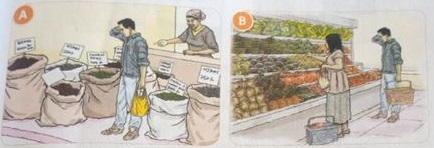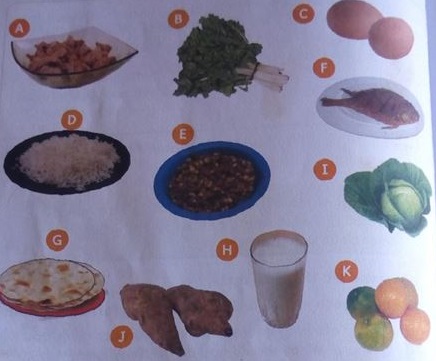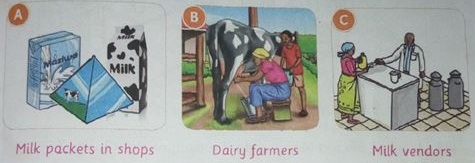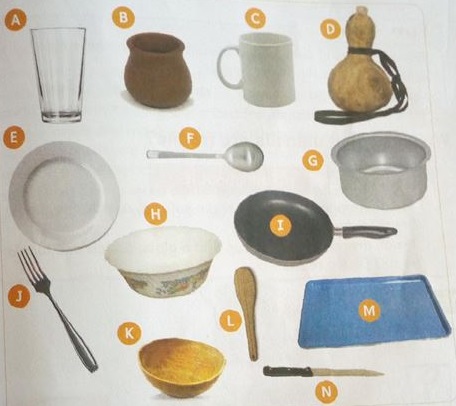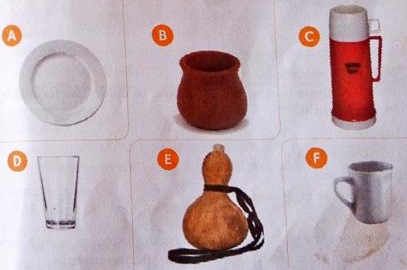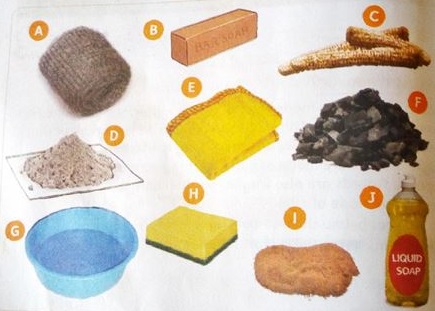- Choosing Foods
- Variety in the diet.
- Preservation Of Milk.
- Fragile Kitchen Utensils.
- Cooking Food.

Choosing Foods
What items do we buy from a general grocery?
- A general grocery is a shop that sells food items and small household goods.
- A grocery shop that sells fruits and vegetables is known a green grocery.
What do we consider when choosing foods from a general grocery?
- The type of material the packaging is made of
- The weight of the item that has been packaged
- The price of the item that has been packaged.
- The date of expiry written on the package.
Exercise
- You have ksh 500 to buy the items below at the nearby grocery shop
1 packet of maize flour at Kshs 120,1 litre milk at Kshs 60, 1 loaf of bread at Kshs 50 and 1 bunch of spinach at Kshs 10 each.- Prepare a shopping list.
- How much money will you use to pay for all the items?
- When receiving your balance, the grocery gives you ksh 20 more. What should you dowith the extra ksh 20?
- What would you look for when buying a packet of maize flour from a grocery shop?
- Write two things that would happen if there was no grocery shop in your village or town.

Variety in the diet.
What foods are available in our locality?
- The pictures below show the foods that are available in our locality.
How do we classify foods?
- Foods can be classified into three groups
- Foods that give us energy
Potatoes, maize, rice, yams, ugali, sorghum. - Body building foods
Meat, chicken, fish, beans, milk, green gram - Protective foods
Mangoes, oranges, kales, spinach, cabbage, kunde, managu
What is variety in the diet?
- Variety in the diet means eating foods from the three food groups.
- A healthy meal has variety. It contains foods fry the three groups in the right amount. This is called a balanced meal or a balanced diet.
Exercise
- Who am I?
- I am oval in shape and white in colour can break easily.
- You give me to babies. I am good for your teeth too.
- Monkeys love to eat me. I turn yellow when I am ripe.
- Look at the list of food items below.
Cassava, groundnut, watermelon, beans, orange, potato, water
Pick one food item to complete the form groups given below.- Ripe bananas, cabby, apple,______
- Rice, ugali, chapati,_______
- Meat, fish, milk,__________
- What is a balanced meal?
- Amoit loves to eat chips and sausages, and to drink soda. She is very happy with her choice of food.
- Is there variety in Amoit's meal? What is missing?
- Do you think Amoit has chosen healthy food to eat? Why?
- What would you choose for Amoit to eat?

Preservation Of Milk.
What are the sources of milk in our locality.
- We get milk from various sources in our locality. We get milk from vendors, shops and dairy farmers.
Why do we preserve milk?
- Fresh milk should be preserved because it goes bad easily
- When it goes bad, it goes to waste.
Reasons for preserving milk.
- To prevent it from getting spoilt.
- To prevent wastage
- To make it last longer
- To make it easy to store and transport.
How do we preserve milk?
They are different methods of preserving milk.
- Boil the milk. Boiling kills germs that make milk to go bad.
- Put the milk in a refrigerator. The low temperatures prevent the milk from going bad.
- Ferment the milk. Fermented milk can be used for a longer time than fresh milk.
- You can also use a home made cooler to preserve milk.
Using different methods to preserve milk.
-
Preserving milk by boiling it.
You will need: a clean sufuria, a jiko, fresh milk and a sieve.- Sieve the fresh milk into a clean sufuria.
- Light the jiko and place the sufuria the fire.
- Heat the milk until it starts to rise.
- Lower the heat and let the milk boil for about one minute.
- Remove the sufuria in a clean place and let the milk cool.
- Once the milk is cool, cover it with a lid.
-
Preserving milk by fermenting it.
You will need: fresh boiled milk, a gourd or a plastic container.- Pour the fresh milk in a gourd or plastic container plastic container.
- Cover the mouth of the gourd or the container tightly using a lid or cock.
- Keep the container or the gourd in a warm place.
- Do not disturb the milk for around two days to allow it to ferment.
- Shake it before you serve it.
Exercise
- Name the sources of milk in your locality.
- Why do we preserve milk.
- Name two uses of milk in our bodies.
- The pictures below show some methods of preserving milk.

- Name the methods.
- How does each method help to preserve the milk?

Fragile Kitchen Utensils.
What are the uses of the various kitchen utensils?
Which kitchen utensils are fragile?
- Kitchen utensils are made from different materials. Some kitchen utensils break easily. Other kitchen utensils do not break easily. Utensils that break easily are called fragile utensils.
- Fragile utensils are made of glass, earthenware and ceramic material.
- Gourds are also fragile. Earthenware and ceramic utensils are made of clay.
- The pictures below show some fragile kitchen utensils.
Which materials do we use to clean fragile kitchen utensils?
- How do we clean,dry and store glasses and thermo flask?
Cleaning a glass
- You will need: a glass,a ponge,sisal fibre or a soft cloth,two basins, warm water,a dish cloth,dish rack.
Procedure
- Put some warm water in a basin
- Wet the glass and sponge.
- Apply some soap on the sponge.
- Wash the glass gently in the warm water. Scrub the inside and outside of the glass.
- Rinse it properly in clean water.
- Wipe it using a dish cloth so as to make it shine. You can also place the glass upside down on a dish rack to dry.
- Store the glass safely in a cupboard.
Cleaning a thermo flask
- You will need: a thermo flask,a sponge,a soft cloth,two basins, soap,warm water, dishcloth and a dish rack.
Procedure
- Put some clean warm water in a basin.
- Apply soap on a sponge,sisal pad or soft cloth and put it in the flask
- Pour some of the warm soapy water in the flask and shake it gently.
- Pour the soapy water and the sponge back in to the basin
- Scrub the outside of the flask and the mouth of the flask, clean the lid.
- Rinse the flask and the lid in clean warm water.
- Dry the flask on a dish rack
- Store the thermo flask safely in a cupboard once dry.
How do we clean,dry and store earthen and ceramic utensils?
- How to clean a clay pot.
You will need: a basin,warm water and a sisal pad or a dry maiza cob.- Put some water in the pot .Leave it in the pot for a few minutes to sock.
- Scrape off the food remains using a sisal pad or a dry maize cob.
- Pour out the dirty water.
- Put some clean water in the pot.Scrub the inside and then the outside of the pot using a pad of sisal fibre.
- Rinse the pot using clean warm water.
- Dry the pot upside down on a drying rack.
- When it is dry ,store it upside down on a storage rack, or keep it standing in a safe corner.
- How to clean a ceramic cup
You will need: a ceramic cup, soap,a sponge,a soft cloth or a pad of sisal fibre,warm water,two basins and a utensil rack.- Put some clean warm water in a basin
- Apply some soap on a sponge
- Dip the cup in warm water. Use the sponge to gently scrub the cupon the inside and on the outside.
- Rinse the cup properly in Clean warm water.
- Dry the cup on a rack
- Once it is dry,store it safely in a cupboard.
- How to clean a gourd.
You will need: a gourd,warm water,a basin, small stones and a sponge or sisal pad.- Put some small stones in the gourd.
- Add some clean warm water.
- Shake gourd gently several times.
- Pour out the water and the small stones.
- Scrub the outside of the gourd with a sponge or sisal pad.
- Rinse the gourd with the warm water until it is clean
- Dry the gourd upside down on a rack. Ensure it is safe.
- When it is dry,store it on a rack ,or hang it on a wall using string.
Safety when cleaning fragile utensils.
- Handle fragile utensils with care.
- Do not stack glasses
- Wash one utensils at a time
- Wash the utensils using a soft material.
- Do not put glasses in very hot water.
- Do not use soap when cleaning clay pots and gourds.
- Always dry gourds and earthen utensils well before storage.
- Store fragile utensils safely away from the reach of children.
Exercise
-
- Name three fragile kitchen utensils you use at your home.
- Write two things you should do when cleaning glasses to make sure they do not break
- You have been asked to show the Learners in your class how to wash a glass.
- Write down three materials you will use
- How will you reuse the water after washing?

Cooking Food.
Why do we cook food?
- We cook food to become soft
- We cook food so that it can be easier to eat
- We cook food for easier digestion
- We cook food for it to taste good
- We cook food to kill germs
- We cook food for it to last longer.
What hygiene practices should we observe when cooking food?
- Wear clean clothes when cooking.
- Cooking food properly
- Washing hands before touching Food.
- Covering head with a cap and wear on apron.
- Cook and serve food in Clean utensils.
- Cover cooked food and keep it in a clean place.
Join our whatsapp group for latest updates
Tap Here to Download for 30/-
Get on WhatsApp for 30/-
Download Foods and Nutrition - Grade 4 Home Science Notes.
Tap Here to Download for 30/-
Get on WhatsApp for 30/-
Why download?
- ✔ To read offline at any time.
- ✔ To Print at your convenience
- ✔ Share Easily with Friends / Students

